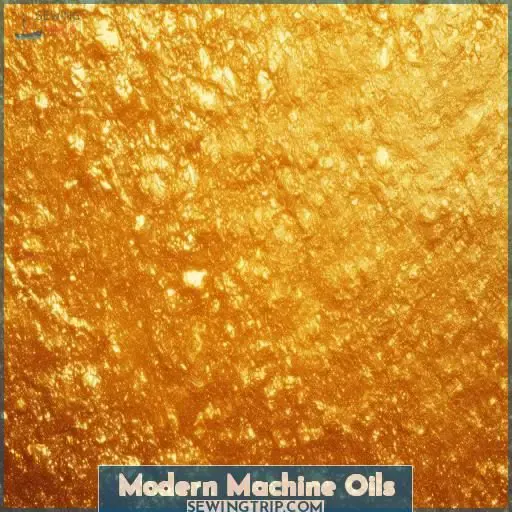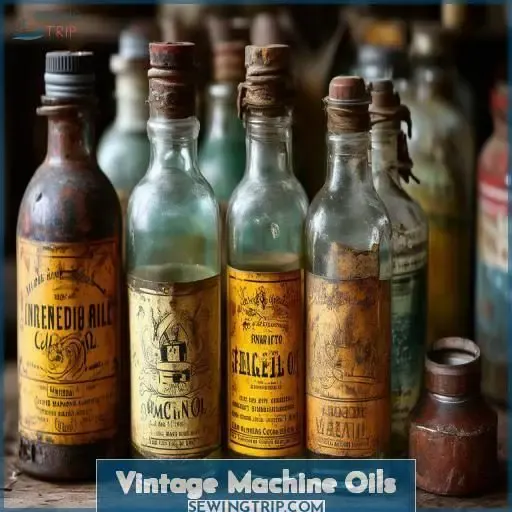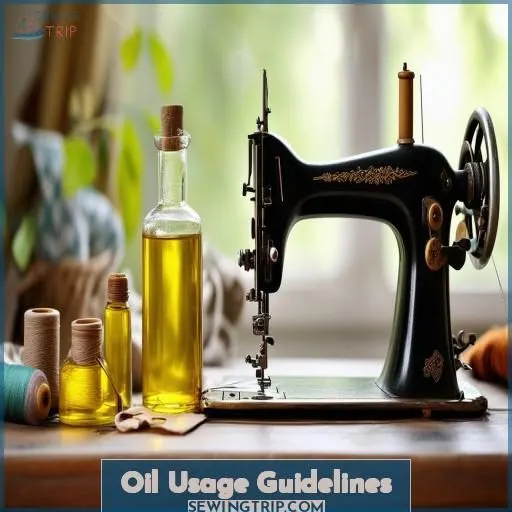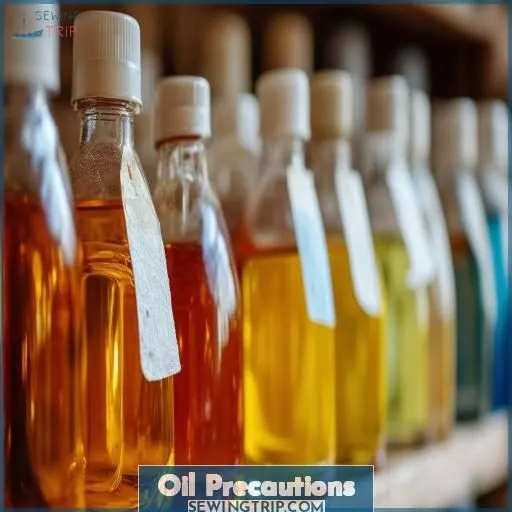This site is supported by our readers. We may earn a commission, at no cost to you, if you purchase through links.
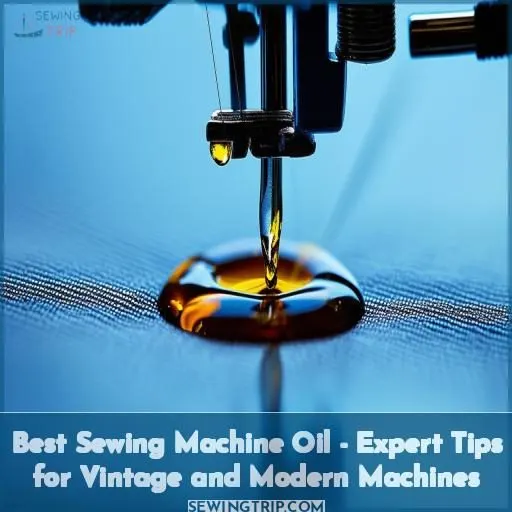 You’ll want to use the best sewing machine oil** for ideal performance.
You’ll want to use the best sewing machine oil** for ideal performance.
For modern machines, follow the manufacturer’s recommendations on viscosity and brand – most require minimal lubrication these days.
Vintage machines, however, benefit from a 50-50 mix of Marvel Mystery Oil and turbine oil to dissolve gunk.
Any sewing machine oil works, but avoid substitutes that could damage components.
For cost-effective options, try Lily White oil in refillable bottles.
Apply as directed, use cotton balls to catch drips, and you’ll soon see why proper oiling is key.
But there’s more to learn for keeping your machine humming.
Table Of Contents
Key Takeaways
- Keeping your sewing machine well-oiled is like giving it a refreshing spa day – it’ll purr with joy and reward you with flawless stitches. Who doesn’t love a happy, rejuvenated companion?
- For modern machines, listen to the manufacturer’s oiling gospel – they know their baby best. But vintage darlings? A sprinkling of that magical Marvel Mystery Oil and turbine oil blend works wonders on ancient gunk.
- Don’t go overboard with the oil slathering, my friend. A little oiling TLC goes a long way toward machine bliss. Too much and you might find yourself slipping and sliding all over the place!
- Embrace frugality when it comes to sewing oils. Lily White Oil is a thrifty gem that’ll keep your machine running like a dream without emptying your pockets. Who says quality has to cost a fortune?
Modern Machine Oils
For modern sewing machines, you’ll want to stick with the manufacturer-recommended oil for best performance.
Most newer machines are designed to run with minimal lubrication, so follow the instructions carefully. Some models are even oilless, eliminating the need for regular oiling.
While WD-40 can be handy for specific areas, it’s not a substitute for proper sewing machine oil. Be sure to use the right viscosity and brand specified by the maker.
Proper oil maintenance, storage, and application are key to keeping your modern machine running smoothly. A little goes a long way, so don’t overdo it on the oiling front.
Vintage Machine Oils
For vintage sewing machines, a 50-50 mixture of Marvel Mystery Oil and Turbine Oil is recommended. This unique blend helps dissolve old oil and shellac buildup while also coating and protecting the metal components.
Oil Mixture
Moving on to vintage machines, you’ll want to use a 50-50 mixture of Marvel Mystery Oil and Turbine Oil. This winning combo:
- Dissolves old gunk and shellac
- Lubricates metal components
- Extends the life of your beloved relic
Keep using the mixture for a month after servicing to make certain your antique stays in tip-top shape. Proper oiling is key to keeping those vintage beauties running smoothly.
Oil Types
Any sewing machine oil can keep your vintage machine running smoothly. But avoid sperm whale oil – it’s unethical and outdated. Brand names often charge a premium, so opt for generic turbine oil – it’s the same as sewing machine oil. Refill zoom-spout bottles for easy application. Remember, a little goes a long way!
| Keep it simple | Nature’s beauty | A hidden gem |
| Smile, it’s contagious | Florals brighten any day | Diamonds in the rough |
| Laughter is the best medicine | Stop and smell the roses | Quality lasts forever |
| Spread joy | Appreciate the little things | Value true craftsmanship |
Oil Usage Guidelines
When oiling your sewing machine, pay close attention to the manufacturer’s recommended oiling ports and locations. A helpful trick is to place a cotton ball under the presser foot to catch any excess oil that may drip down.
Oiling Ports
Properly oiling your machine is essential. Here’s how to do it correctly:
- Locate the oiling ports as specified in the manual
- Use the recommended oil viscosity and type
- Apply a few drops of oil every use or as directed
- Avoid oil substitutes – they can damage your machine
With consistent, proper oiling, your sewing machine will run smoothly and last for years. Don’t neglect this vital maintenance task!
Cotton Ball Trick
While oiling ports, place a cotton ball under the machine’s foot to absorb any excess oil. This prevents oil from spreading and damaging your fabric or workspace. Strategically positioning the cotton ball protects your prized machine from unsightly spills and stains. A simple yet ingenious hack, the cotton ball trick guarantees a clean, well-oiled sewing experience.
Cost-Effective Options
For a cost-effective sewing machine oil option, consider Lily White oil which is priced at an economical $0.33 per ounce. To further maximize its value, you can refill smaller zoom-spout bottles from the larger Lily White oil container, allowing for easy and precise oil application without waste.
Lily White Oil
You’re in luck – Lily White sewing machine oil is a cost-effective gem. At just $0.33 per ounce, a gallon will keep you oiled up for ages. A few essential drops per spot is all you need from this affordable lifesaver:
- Long-lasting supply
- Expertly lubricates machines
- Frugal price tag
- Convenient gallon size
Don’t overspend on fancy brands when Lily White does the trick.
Refillable Bottles
Refilling bottles offers the convenience of storing your sewing machine oil long-term. Look for glass or plastic bottles ranging from 2-8 oz, ensuring compatibility with your preferred sewing oil. Zoom-spout tops make refilling a breeze, allowing precise oil application. This cost-effective option keeps your machine running smoothly without breaking the bank.
Oil Precautions
One vital precaution is to strictly follow the manufacturer’s recommended oil for your sewing machine, as using an incorrect type of oil can potentially damage the intricate components. It’s also advisable to avoid using organic oils or typical household mineral oils, as they aren’t designed for machinery and may lead to corrosion or other issues over time.
Manufacturer Recommendations
In addition to cost-effective options, you’ll want to closely follow the manufacturer’s recommendations for oiling frequency and types of oil. Compare their guidelines to the general tips provided, as some machines may require specific oil additives or prohibit certain substitutes. Proper oil storage is also essential to prevent contamination or degradation.
Avoid Incorrect Oils
Avoid using the wrong oil – it’s a safety precaution. Using oils like mineral oil or vegetable oils can cause:
- Viscosity issues, leading to leaks and damage
- Gumming or residue buildup that clogs components
- Corrosion from unrefined oils that contain impurities
Store sewing machine oils properly and only apply the manufacturer-recommended type. Taking these precautions protects your investment.
Frequently Asked Questions (FAQs)
What is the shelf life of sewing machine oil?
Sewing machine oil, that liquid gold, has a decadent shelf life – around 5 years when unopened. Once popped, use it within 2-3 years for peak performance. Proper storage in a cool, dry place guarantees its longevity and keeps your machine purring like a kitten.
Can sewing machine oil be used for other purposes?
While sewing machine oil is designed for lubricating sewing machines, you can use it for other light machinery like bicycles or clocks. However, it’s best to stick to the manufacturer’s recommendations for best performance and longevity.
How often should sewing machines be oiled and lubricated?
The well-oiled path to machine longevity? Follow the manufacturer’s guidance – usually every few uses for modern marvels, monthly for vintage gems. Proper lubrication keeps precision parts gliding smoothly.
Are there any eco-friendly or biodegradable sewing machine oils?
Yep, you’ve got eco-friendly options like BioBlend sewing machine oil made from vegetable oils. Just be sure to check your machine’s instructions – some vintage models may need petroleum-based oils to run smoothly.
What are the signs that a sewing machine needs oiling?
You’ll know it’s time to oil your sewing machine when it starts sounding noisy, feeling sluggish, or leaving imperfect stitches on the fabric. Regular oiling helps your trusty companion run smoothly, so don’t neglect this essential maintenance task.
Conclusion
Like a well-oiled machine, your sewing endeavors deserve the best sewing machine oil for ideal performance.
By heeding manufacturer guidelines, employing cost-effective Lily White oil, and properly lubricating vintage models, you’ll extend your machine’s lifespan.
Thoughtful oiling practices, such as using cotton balls, prevent drips and ensure smooth stitching.
With the right oil and application, your trusty machine will hum along, project after project.

